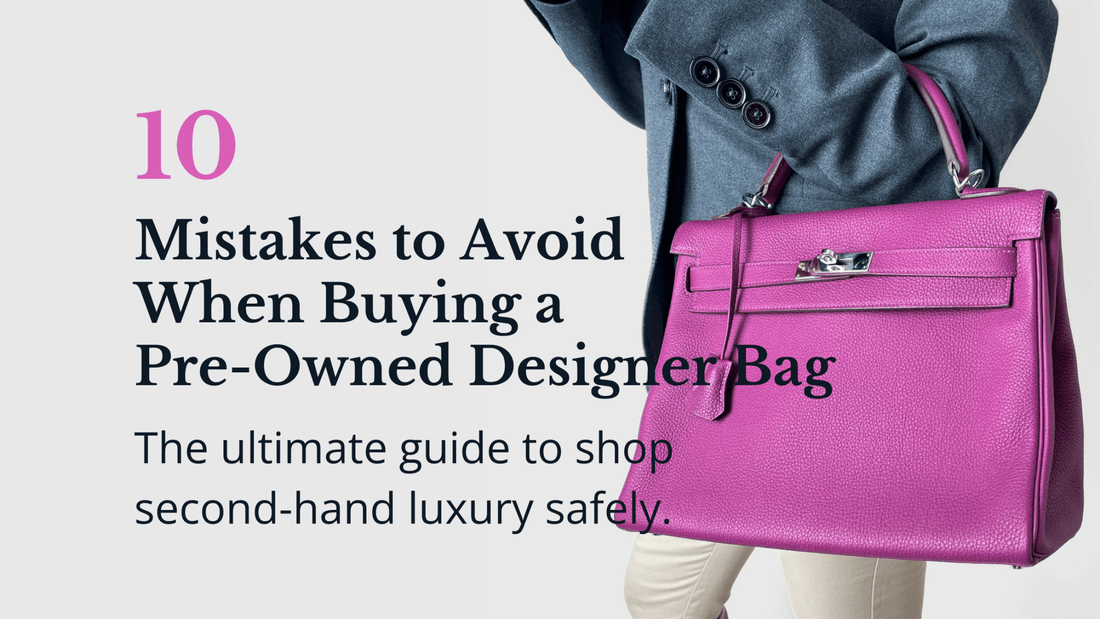
10 Mistakes to Avoid When Buying a Pre-Owned Designer Bag
Shopping second-hand is not just a trend — it is a more thoughtful way to invest in timeless luxury.
But purchasing pre-owned designer bags still involves risks.
Whether it is a Louis Vuitton Neverfull, a vintage Chanel Flap, or a Dior Saddle, the process can be exciting, but also confusing.
And with resellers increasingly present online, it is easy to make costly mistakes, even when acting with caution.
At Tabita Bags, we speak daily with women who have received counterfeit products, damaged items, or simply experienced doubt or regret after a purchase that did not meet expectations.
Here is what we have learned — and what we believe every luxury buyer should understand before investing in her next piece.
1. Trusting the Wrong Seller
A visually appealing website or curated social media feed does not guarantee trustworthiness. Before making a purchase, consider the following:
- Is the seller a legally registered business?
- Do they offer a return policy — not just “final sale” conditions?
- Are their customer reviews consistent, traceable, and verifiable?
- Can they be contacted reliably via phone or email in case of issues?
A seller without a legal presence can disappear without notice.
If customs or authorities question your purchase, presenting a registered business is very different from showing a personal Instagram profile.
2. Overlooking the Return Policy
A return policy may seem secondary, until something goes wrong.
Photographs cannot capture every detail. You may receive:
- A pre-owned bag with a strong odour (such as smoke or perfume)
- Signs of wear that were not visible in the listing
- A size or shape that does not suit you once held in person
One of our clients purchased a vintage bag from a Swiss reseller that did not allow returns.
The item arrived with a persistent, unpleasant smell. Being sensitive to scent, she placed it in storage.
A few weeks later, she discarded it, without refund or support. A valuable bag was lost.
In another case, we ordered a bag from a long-standing B2B partner.
Upon opening the package, a strong chemical odour emerged, likely due to material degradation. It was intense enough to cause physical discomfort.
Because we have a formal return agreement in place, we reported the issue immediately.
That bag is still being aired, and thankfully, we are not obligated to keep it.
This is the purpose of a return policy. It is not a formality, it is a safeguard when the unexpected occurs.
3. Skipping the Fine Print
The most critical details are often not in the product listing but in the fine print.
Before completing a purchase, review:
- Who is responsible if the item is lost during shipment?
- Are discounted items eligible for returns?
- What does the seller specifically mean by terms like “excellent condition”?
At Tabita Bags, our terms are clear and transparent. No hidden clauses — because you deserve certainty when purchasing a luxury item.
4. Believing “Like New” Means Perfect
There is no standardised condition scale in the resale market.
What one seller describes as “excellent condition” may differ significantly from another’s definition.
In the second-hand industry, terms such as:
- “Good” may mean heavily used
- “Very Good” may still involve noticeable flaws
Even experienced sellers can be inconsistent. Do not rely solely on general descriptions. Always ask for clarification and request unedited, close-up images.
At Tabita Bags, when we say “like new,” we mean:
- Never used
- No odours
- No concealed defects
Unfortunately, not all sellers follow the same standards.
And minor imperfections can lead to major disappointment upon arrival.
Pay special attention to:
- Rubbed corners
- Cracked handles
- Interior stains
- Sticky surfaces caused by heat or material wear
Always request detailed photos showing:
- Stitching
- Corners and edges
- Bag interior
- Serial numbers
- Logos and hardware
If such details are not provided, proceed with caution.
5. Falling for Misleading Descriptions
Some sellers use product language that can seem reassuring but is actually vague or ambiguous. For instance:
- “Good” might mean clear signs of use
- “Very Good” may still involve visible flaws
- “New tag” could indicate the original tag was removed and replaced with a non-authentic one
While not necessarily deceptive, these descriptions can be misunderstood if not clearly explained.
In addition, photography can be selectively presented. Some sellers deliberately obscure flaws using lighting or camera angles. In some cases it is just difficult to represent correctly some parts of a bag.

We once received a video from a consignor showcasing a bag in excellent condition.
When the item arrived, the corners were significantly worn, a detail not shown in the video. This is why it is essential to carefully examine:
- Corners
- Handles
- Zippers
- Stitching
If specific areas are not shown, there may be a reason.
6. Thinking You Can Spot a Fake Pre-Owned Designer Bag
This is one of the most common and expensive misconceptions.
We have examined two Gucci Marmont Small Black bags side by side, one authentic and one counterfeit.
Even with both in our hands, it was almost impossible to distinguish the difference with the naked eye. Today’s counterfeit products are highly advanced:
- False serial codes
- Replicated holograms
- Nearly identical hardware
- Fake receipts and documentation
At Tabita Bags, we use Entrupy and other professional authentication tools.
Thanks to these we find that approximately 5% of the items we received are identified as fake.
"the quality of counterfeit luxury goods is improving. Even trained experts have a hard time distinguishing real from fake"
We have talked with various big players that supply designer bags resellers and we estimate that only 70% of their business clients use authentication tools. This means many counterfeit items still enter the market, even through professional resellers.
We are contacted daily by “suppliers” from Turkey, China, and even Florence, claiming to sell authentic goods.
Many small resellers purchase from them and do not authenticate items properly.
Authenticity depends not only on the product but on the seller’s integrity and verification process.
“We’ve held fakes in our hands that would fool 99% of people — even some professionals. That’s why we never rely on gut feeling. We use tech.”
If a seller is not authenticating each item with technology — not just their own judgment — the risk is too high.
7. Ignoring the Risks of Buying Outside Switzerland
International purchases may appear more affordable but can come with complications:
- Customs delays or seizures
- Lost or untraceable packages
- Limited legal recourse
We have even heard from customers who received a CHF 1,000 fine after unknowingly importing counterfeit goods. In Switzerland importing or selling fakes is a crime heavily punished.

Beyond the personal loss, counterfeit products fuel criminal networks and unethical labour.
By choosing a Swiss-based business, you benefit from:
- Consumer protection under Swiss regulation
- Valid purchase invoices
- Traceable shipping
- Genuine customer support
8. Not Reading Between the Reviews
Online reviews are valuable, but many are fabricated. To verify credibility:
- Look for verified buyer badges (e.g., Trustpilot)
- Check if customers share names or product photos
- Be cautious of short, repetitive reviews posted close together
Some sellers use paid reviews or generate them internally. We receive offers to buy reviews almost daily. If reviews praise “fast shipping” or “great service” but do not reference the product itself, consider it a warning sign.
At Tabita Bags, our reviews come from verified clients over time. One honest review per transaction, not manufactured in bulk.

9. Believing that the Receipt Proves Authenticity
It is a common assumption, but a receipt does not guarantee authenticity.
We are frequently asked whether a pre-owned bag comes with its original purchase receipt.
The answer is: rarely. And when it does, we typically do not share it, as receipts often contain sensitive personal information. More importantly, a receipt can be misleading.
One client brought us 19 Louis Vuitton bags to consign. Only one had a receipt, and that item turned out to be counterfeit. The receipt appeared legitimate. The store? One of the most respected in Switzerland, publicly committed to anti-counterfeit policies.
However, based on Entrupy and additional checks, the bag was proven to be inauthentic. This is not unusual. Real receipts are often matched with fake bags to deceive buyers. There is a market of real accessories to go with fake items.


That is why authentication, is what truly matters.
10. Assuming Marketplace Platforms Offer the Best Price
Today, many second-hand luxury bags are listed on on big global marketplaces. But behind the polished interface, these platforms are simply intermediaries. Most items are sold by private individuals or third-party resellers.
And here's what most buyers don’t realise: because the platforms have a commission-based model, sellers must increase their prices to protect already thin margins.
In many cases, the final price ends up higher than the original retail price, especially for newer or popular models.
At Tabita Bags, we are present on various marketplaces, but our prices there are always higher than on our own website. Not by choice, but because platform fees leave no alternative.Beyond pricing, consider the customer experience. Many users of big platforms report mixed feedback. A quick look at public reviews on Trustpilot or social media reveals frequent concerns:
slow responses, poor communication, and complicated returns.
That’s why buying directly from a trusted, specialised store often provides a better overall experience: clearer policies, faster answers, and direct accountability.
At the same time, if you must choose between buying from an unknown individual and buying through a platform, the platform is safer. It adds a layer of buyer protection that private sellers simply cannot guarantee.
Still, for peace of mind and better pricing, the best option is often the original source.
Final Thoughts: Do Not Let Luxury Become Regret
Whether you are purchasing your first Louis Vuitton or adding a rare Chanel to your collection, do so with clarity, protection, and peace of mind.
At Tabita Bags:
- Every item is authenticated using professional tools
- We do not source from grey markets or drop ship
- We offer a transparent return policy
- We are a Swiss-registered company — not just a social media page
We are here to assist you — with no pressure, only genuine advice.
👜 Explore our collection of second hand designer bags
💬 Or contact us for tailored guidance — because the right bag should never feel like a risk.

 https://tabitabags.ch
https://tabitabags.ch